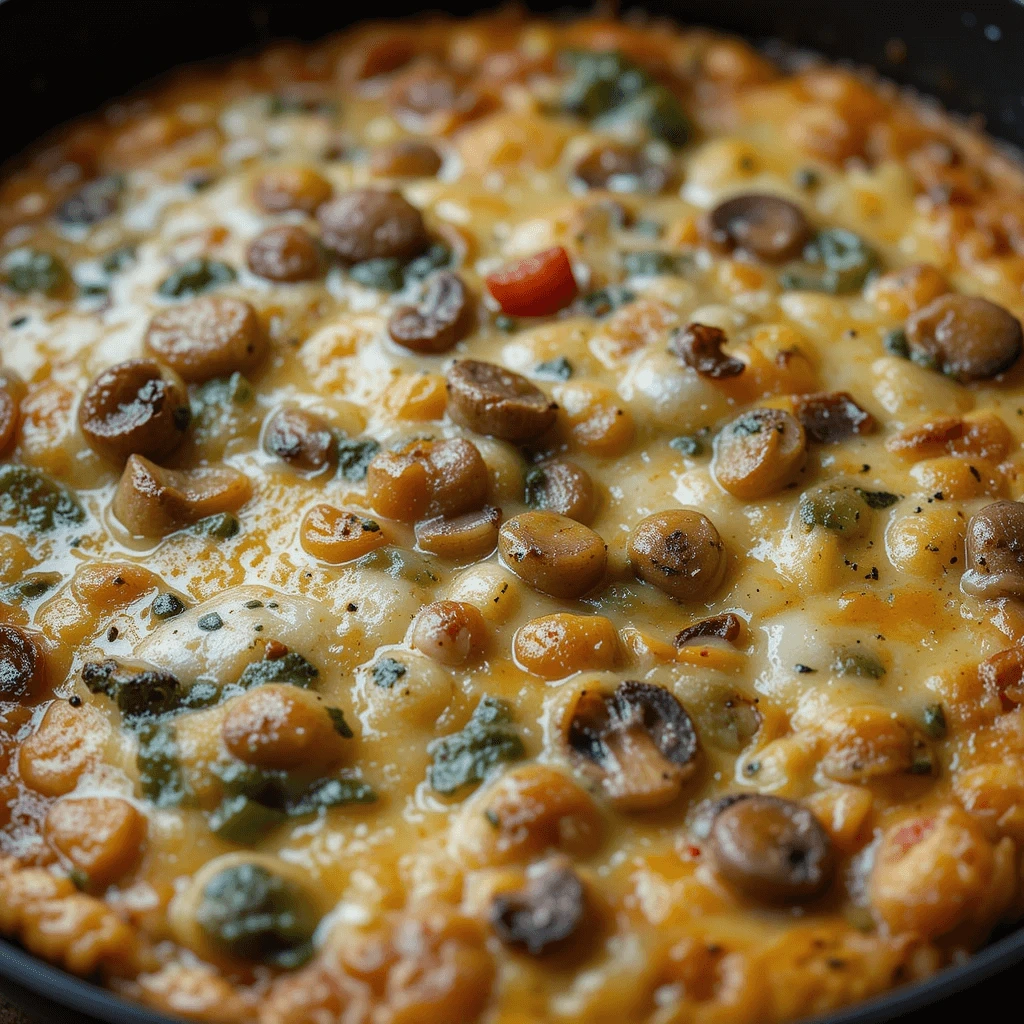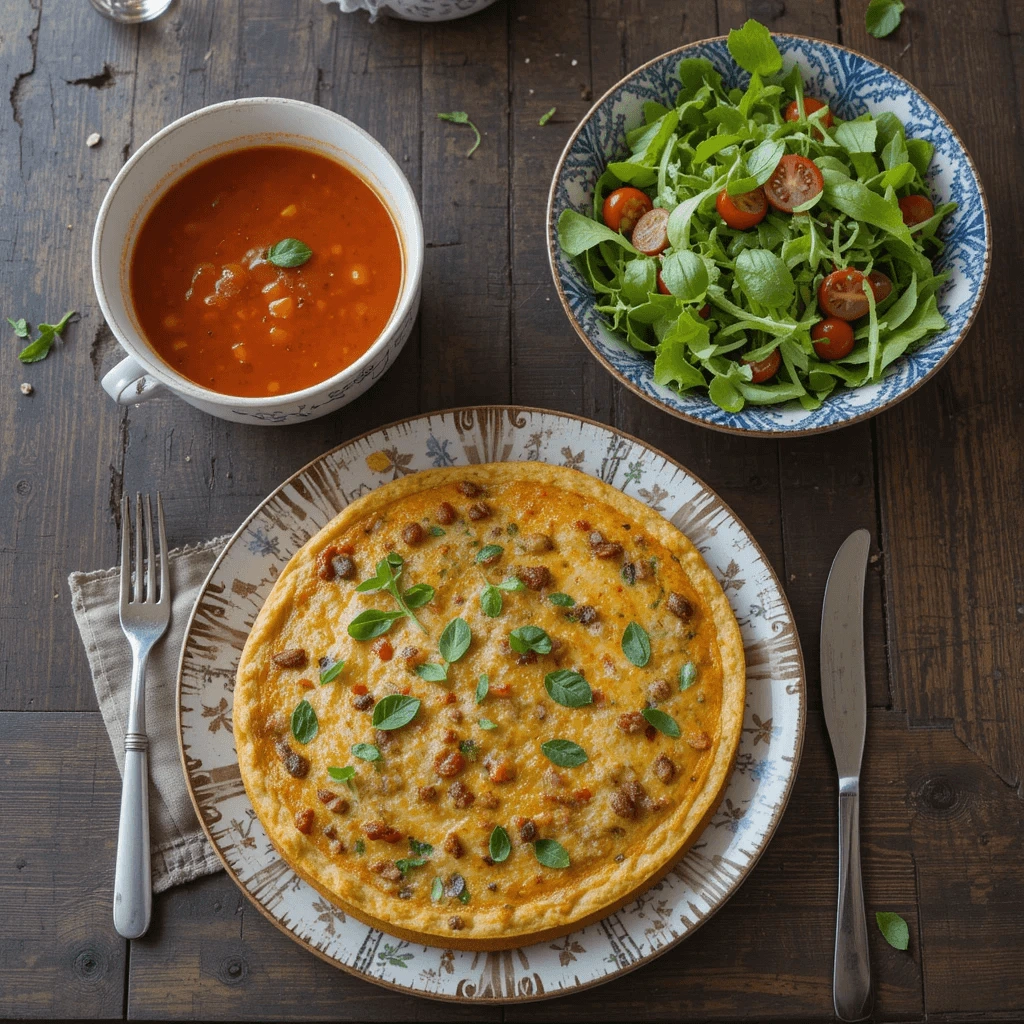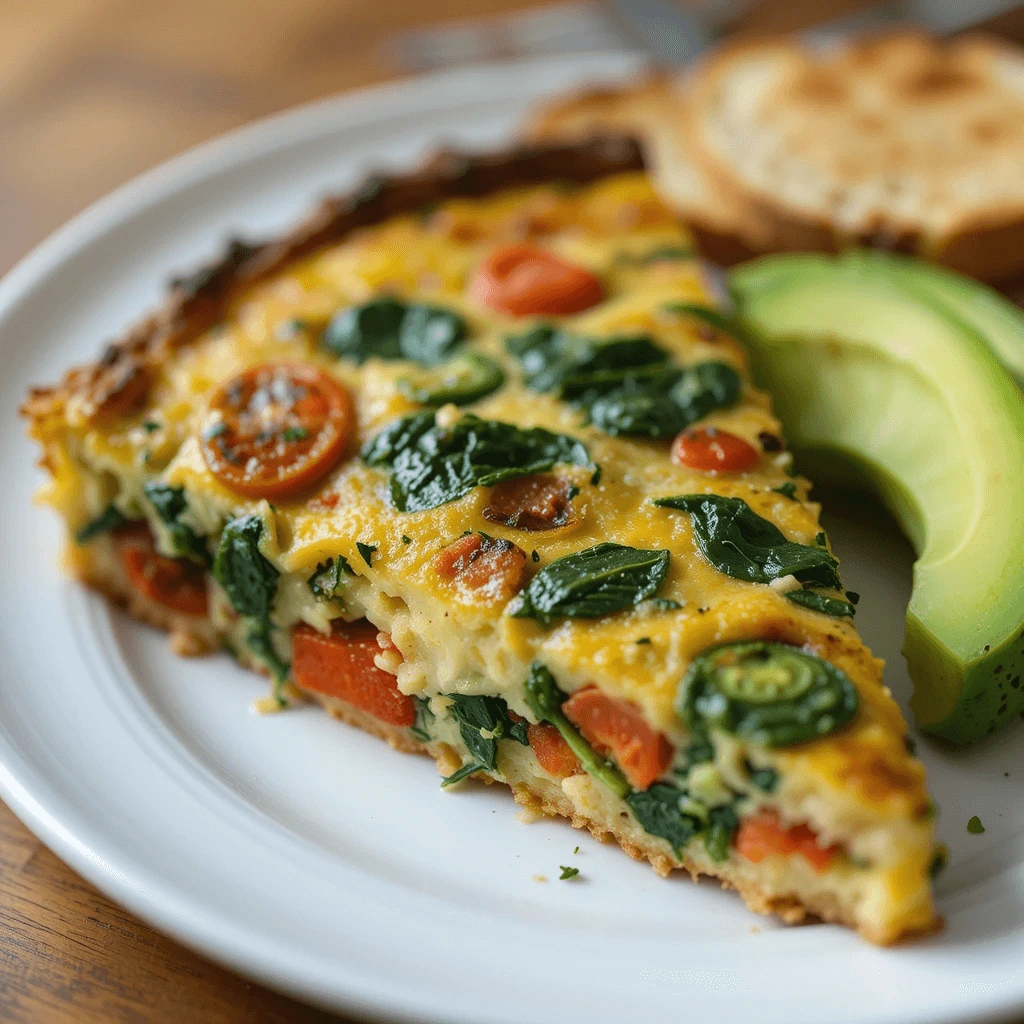A frittata is one of the easiest and most versatile dishes you can make. Whether you need a quick breakfast, a healthy lunch, or a light dinner, this easy frittata recipe is perfect for any meal. Made with eggs, fresh vegetables, cheese, and your favorite proteins, it’s packed with flavor and nutrition.
Unlike an omelet, a frittata is cooked slowly and finished in the oven, creating a fluffy and delicious texture. Plus, it’s meal-prep friendly, so you can make it ahead and enjoy it throughout the week. In this post, you’ll learn how to make the best frittata recipe, customize it with different ingredients, and serve it with delicious sides. Let’s get started!
Why You’ll Love This Easy Frittata Recipe
A Quick and Healthy Meal
A frittata is a quick, nutritious meal made with simple ingredients like eggs, fresh vegetables, and cheese. Eggs provide protein, healthy fats, and vitamins, while veggies like spinach, bell peppers, and mushrooms add fiber and flavor. Cheese like feta or mozzarella adds creaminess and richness.
What makes frittatas great is their versatility – they’re perfect for breakfast, lunch, or dinner. Serve it hot, cold, or at room temperature, making it ideal for meal prep. Whether you need a fast breakfast, a protein-packed lunch, or a light dinner, this easy recipe fits your routine.
Versatile and Customizable
A frittata’s versatility is one of its best features. You can easily customize it by adding ingredients like spinach, mushrooms, or bell peppers for a veggie-packed dish. If you prefer more protein, chicken, turkey, or sausage are great options to make it more filling.
You can also mix in your favorite cheeses such as mozzarella, feta, or cheddar to enhance the flavor and texture. Fresh herbs like basil or parsley can add a refreshing touch.
With endless combinations, you can tailor your frittata to suit any dietary preference, making it the perfect meal for any time of day.
Great for Meal Prep
A frittata is perfect for meal prep. Bake it ahead, store it in airtight containers, and it keeps well for several days. This convenient, nutritious meal is ready whenever you need it.
Frittatas can be eaten hot, cold, or at room temperature, making them ideal for busy mornings or quick lunches. They’re also great for grab-and-go breakfasts or paired with a side salad for a light dinner.
You can customize your frittata by adding a variety of vegetables, lean proteins, and cheeses, ensuring a balanced and flavorful meal. Make a large batch for a protein-packed option that’s ready to fuel your day.
Essential Ingredients for a Flavorful Frittata
Eggs and Dairy – The Base of a Creamy and Fluffy Frittata
Eggs are the foundation of a frittata, providing protein, healthy fats, and essential vitamins. When cooked gently, they create a fluffy, light texture that makes the frittata satisfying.
Dairy, such as cheese or milk, enhances the creaminess and richness. Cheeses like mozzarella, cheddar, or feta add flavor, while milk or dairy-free alternatives like almond milk keep it lighter.
Eggs and dairy work together to create the perfect balance of creaminess and fluffiness, making the frittata a versatile, delicious meal that pairs well with any ingredients.
Vegetables and Proteins – Bell Peppers, Tomatoes, Sausage, or Turkey for Extra Flavor
Adding vegetables and proteins to your frittata boosts both flavor and nutrition. Bell peppers, tomatoes, and spinach contribute vibrant color, fiber, and vitamins, while adding a fresh, light taste.

For protein, sausage, turkey, or chicken provide a savory depth and help keep you full longer. Sausage adds bold flavor, while turkey and chicken are lean options that complement the creamy texture of eggs.
You can also experiment with mushrooms, onions, or zucchini for added variety. The combination of veggies and proteins creates a satisfying, well-rounded frittata, perfect for any meal.
Herbs and Cheese
Herbs and cheese are key ingredients that take a frittata from good to great. Fresh herbs like basil, parsley, or chives bring aromatic brightness, with basil offering a sweet, peppery flavor and parsley providing a fresh, grassy taste. These herbs add layers of flavor, enhancing the overall dish.
Cheese adds richness and depth. Feta provides a tangy, crumbly texture, while mozzarella delivers a mild, melty creaminess. For a more robust flavor, try adding cheddar or goat cheese for extra richness and complexity.
Incorporating herbs and cheese at the end of cooking ensures they retain their fresh flavor and contribute to a satisfying, well-rounded frittata. The combination of creamy cheese and vibrant herbs makes every bite more delicious and memorable.
Step-by-Step Guide to Making the Perfect Frittata
Step 1: Prepare the Ingredients – Chop Veggies, Cook Proteins, and Whisk Eggs
- Chop vegetables: Start by chopping about 1 cup each of bell peppers, onions, and spinach (or any veggies you prefer). Make sure to cut the vegetables into bite-sized pieces to ensure they cook evenly. You can also add mushrooms, tomatoes, or zucchini for extra flavor and texture. This step helps the veggies mix well with the eggs, ensuring an even distribution throughout the frittata.
- Cook proteins: Choose your preferred protein, such as 1/2 to 1 cup of cooked sausage, turkey, or chicken. For sausage, crumble it into small pieces as it cooks, allowing the flavors to distribute throughout. If you’re using leaner meats like chicken or turkey, cook them until fully done, then chop into small, bite-sized chunks. These proteins will give your frittata a hearty, satisfying texture while adding essential protein to the dish.
- Whisk eggs: In a separate bowl, crack 6 to 8 large eggs, depending on how large your frittata will be. For a creamier texture, add 2 to 3 tablespoons of milk or cream, which will help the eggs fluff up while cooking. Be sure to whisk the eggs well, making sure the mixture is smooth and free of lumps. A well-beaten egg mixture will ensure your frittata has a light, fluffy consistency.
These preparations will create the perfect foundation for your frittata, with evenly cooked vegetables, flavorful proteins, and a creamy egg base that brings everything together.
Step 2: Cook on the Stovetop or Bake in the Oven – Use a Cast Iron Pan for Even Cooking
- Heat the pan: Start by heating a cast iron pan over medium heat, adding a small amount of olive oil or butter to prevent sticking. The cast iron pan ensures even heat distribution for a perfectly cooked frittata.
- Cook on the stovetop: Pour the prepared egg mixture into the pan, and cook for about 2-3 minutes. Let the edges firm up while the center stays slightly soft. This gives your frittata a nice golden crust on the bottom while keeping the texture tender.
- Transfer to the oven: Preheat your oven to 375°F (190°C). Once the edges of the frittata have set, transfer the pan to the oven. Bake for 10-15 minutes until the frittata is fully set and golden on top. Check by gently shaking the pan—the center should no longer jiggle. This method ensures an evenly cooked frittata with a crisp bottom and fluffy texture throughout.
Step 3: Serve and Enjoy – Let it Cool, Slice, and Pair with a Fresh Salad or Toast
- Let the frittata cool: Allow the frittata to rest for about 5-10 minutes after removing it from the oven. This cooling period helps the frittata set, making it easier to slice and ensuring it holds its shape when served.
- Slice the frittata: Cut the frittata into 6-8 portions, depending on the size and number of servings. You can use a sharp knife or a spatula to carefully slice through the fluffy layers.

- Pair with sides: For a complete meal, serve the frittata alongside a fresh salad (mixed greens, cucumbers, and a light vinaigrette) to add crunch and brightness. Alternatively, pair with toast—try avocado toast or whole-grain toast for added flavor and texture. These sides balance the richness of the frittata, making for a satisfying and nutritious meal.
Variations and Serving Ideas for Your Frittata
Low-Carb and Gluten-Free Frittata – Skip the Dairy or Use Almond Milk
- Skip starchy vegetables: For a low-carb frittata, avoid high-carb ingredients like potatoes. Instead, load your frittata with low-carb veggies such as spinach, zucchini, bell peppers, and mushrooms. These vegetables provide bulk, flavor, and essential nutrients without the added carbohydrates, making your frittata light and diet-friendly.
- Ensure gluten-free ingredients: Frittatas are naturally gluten-free since they mainly consist of eggs and vegetables. However, if you’re using any packaged ingredients like cheese or seasonings, be sure to check labels to confirm they are gluten-free. This ensures that the entire dish meets your dietary needs.
- Use dairy-free substitutes: If you’re avoiding dairy, replace regular milk or cream with almond milk or another plant-based milk like coconut or oat milk. For added creaminess, you can use dairy-free cheese options like vegan cheese or nutritional yeast, which will still give you the richness and flavor without the dairy. These substitutions make the frittata both dairy-free and suitable for those with lactose intolerance.
Spicy Frittata Recipe – Add Jalapeños, Chili Flakes, or Pepper Jack Cheese
For those who enjoy a little heat in their meals, a spicy frittata can add an exciting kick to your breakfast, lunch, or dinner. By incorporating spicy ingredients, you can elevate the flavor profile of your frittata and add a bold twist.
- Add jalapeños: Fresh jalapeños are a great way to bring a crisp, fresh heat to your frittata. You can finely chop the jalapeños and sauté them with your vegetables before adding the eggs. If you prefer a milder spice, remove the seeds, or use just a small amount. For an extra fiery punch, keep the seeds in or add more jalapeños to taste.
- Chili flakes or hot sauce: Chili flakes or a few dashes of hot sauce can easily enhance the heat in your frittata. Sprinkle chili flakes into the egg mixture before cooking or use them as a garnish. Hot sauce can also be drizzled over the finished frittata for a tangy heat that complements the other ingredients.
- Pepper Jack cheese: For both spice and creamy richness, swap your regular cheese for pepper jack cheese. This cheese adds a spicy, flavorful kick while melting perfectly into the egg mixture. You can shred it and mix it into the eggs before cooking, or sprinkle it on top for a golden, cheesy finish.
By incorporating one or more of these spicy elements, you can turn a classic frittata into a fiery, flavorful dish that’s sure to excite your taste buds!
Best Side Dishes to Serve – Pair with Avocado, Toast, or a Light Soup
- Avocado: Adding avocado to your frittata brings a creamy, rich contrast. Serve sliced avocado on the side or mash it and spread it on toast for a flavorful and nutritious complement. The healthy fats in avocado balance the protein and veggies in the frittata.

- Toast: Toast pairs perfectly with a frittata, offering a crunchy texture that contrasts the softness of the eggs. Opt for whole-grain toast for extra fiber, or enjoy avocado toast for added richness. Drizzle with a little olive oil or sprinkle with garlic powder for extra flavor.
- Light Soup: A light soup, like vegetable or tomato basil, pairs well with a frittata, providing a smooth, warming complement. It adds flavor and hydration without overpowering the dish. A clear broth or chicken soup is another great option, enhancing the meal without overshadowing the frittata’s taste.
These sides add texture, balance, and extra flavor, making your frittata meal more satisfying and enjoyable.
If you’re looking for more easy and healthy recipes, be sure to check out our Smothered Potatoes Recipe! It’s rich, creamy, and full of flavor, making it the perfect side dish or main course. Don’t miss out on this delicious, comforting recipe!

